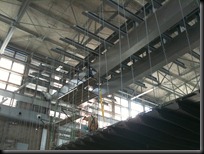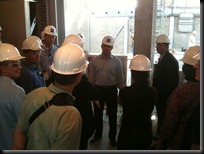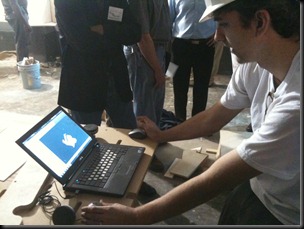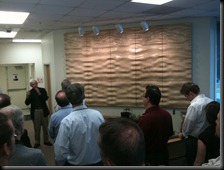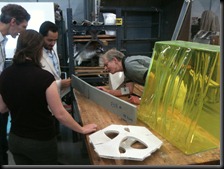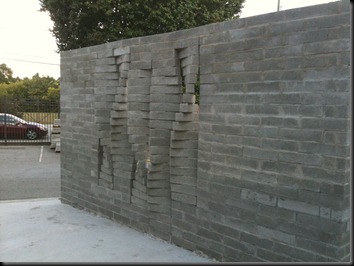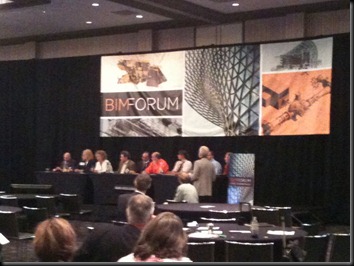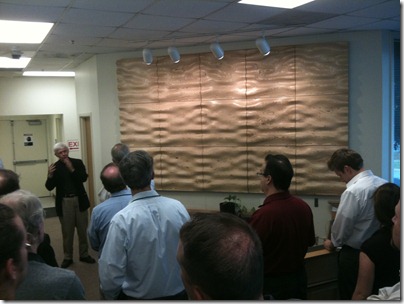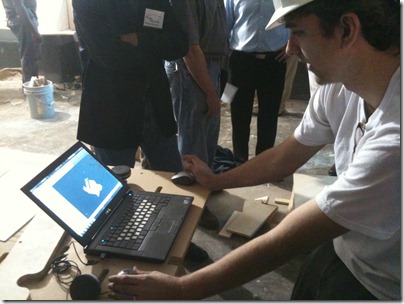
Friday, October 29, 2010
Wednesday, October 27, 2010
Revit Essentials
Anyone ever watch that famous interview with Salvador Dali? It was kinda like that. There was this crazy guy in a suit spouting off terms like 'Relinquish All Mine' and 'Reload Latest' and 'you can totally build a ramp made out of gyp. board and attach it to the bottom of a stair and call it a ceiling.' I was completely lost but totally intrigued.

Want your own copy of that memory? Phil is now leading the made-for-home version of this experience. We're doing a new series of book called Revit Essentials which is going to mimic that 3 day, intensive class you once went through. We're about 50% complete and it's been an interesting process trying to distill 3 days worth of training into a compact book. It won't be out until next year but we're hoping to take it in a new and interesting learning direction.
Monday, October 25, 2010
Event Recap: BIMForum Atlanta
Note: My conference notes were captured exclusively via Evernote on the iPad!
In my last post, I shared just a few pictures from the first pre-conference event at BIMForum Atlanta. In this article, I will summarize the experience of attending my third BIMForum event. In prior years, I had participated in this conference in Falls Church, VA and Dallas, TX – both of which were definitely worth the trip.
This time around, the AGC stuck with the modus operandi of a themed conference. Held at the W Hotel Midtown, the theme was “The Evidence of BIM” or “The Evidence on BIM” – depending on which handout I was reading…perhaps an interesting typo, but I digress. As always one of the main benefits of this type of event is the face-to-face networking - especially outside my ‘comfort zone’ of BIM management. The BIMForum touts one of the most diverse audiences that I’ve seen to date. A quick survey by BIMForum chairman, John Tocci, indicated an even mix of architects, engineers and contractors with a smaller contingency of those representing the owner & facility operating community.
Now, back to the theme…which I’ll simplify as “Evidence” for the sake of this article. The initial marketing leaned towards providing case studies of firms and organizations using or requiring BIM and the benefits they are realizing as a result. Presentations were delivered from a variety of industry sectors, some of which didn’t seem to fit within the “Evidence” theme. I now realize this is not necessarily a bad thing. Recalling the Dallas conference, the overall theme seemed to be forced into the last few slides of EVERY presentation, whether the lecture had anything to do with the theme or not. For that, I’m thankful.
Before I dive into a more detailed review of some key presentations, please note that some or all of the presentation material should be available on the BIMForum.org website soon.
BIMForum Tours
What has become a staple of these conferences, I signed up for the pre-conference BIM tour. This time we visited the campus of Georgia Tech, a really beautiful university that is close to downtown Atlanta. First we were lead on a tour of an addition to the school of architecture being constructed by Beck Group. Of interest was the fact that they assumed the role of the subcontractor for the furniture contract and used some interesting tools and techniques. They had quite a learning curve as they worked with point clouds from laser scans of existing stairwells to append new millwork rails. The workflow seemed a bit convoluted (Rhino to Inventor to EdgeCam to CNC Router), but ultimately was the best available to the team.
The second part of the tour brought us to the Digital Building Laboratory with Chuck Eastman. This is a large facility that was formerly dedicated to advanced wood engineering, but is transforming into research of other materials such as precast concrete and masonry. You can read more about their expertise and projects at www.dbl.gatech.edu. Of note is a new masters degree program being offered next year called Master of Science in Digital Design and Fabrication (MSDDF).
Conference Day 1
Back at the W Hotel, we began the conference with a variety of presentations kicked off by Debajyoti Pati of HKS speaking about evidence-based design. He stressed the importance of the role of the designer in identifying the strategic goals of their clients. Based on results from the medical field where research is used in an attempt to reduce preventable deaths at hospitals, Pati suggests that energy performance predictions will improve occupied facilities and clash detection methods will enhance the construction process.
From Georgia Tech, Chuck Eastman discussed the work he has been doing with GSA in simulating and analyzing circulation routes in early design models. He and his students have also been using Solibri to translate models for use in energy analysis software. This is an interesting departure – using a model checking program – instead of using a direct API tool for exporting or relying on IFC. Ioannis Brilakis spoke about his research with automated real-time videogrammetry (ART-V). You really have to check out more info at the Construction Information Technology Laboratoty (citl.gatech.edu) to fully understand the importance of this technology to the industry! Jochen Teizer also spoke about his work with the Real-Time Automated Project Information and Decision Systems (RAPIDS) lab which can be found at www.rapids.gatech.edu.
Bruce Hunn from ASHRAE gave a presentation about performance measurement protocols for commercial buildings which was interesting, but a bit of a dry topic. I’ll be sure to collect his slides for future reference if they are made available on the BIMForum website. Following Bruce was Josh Oakley and Frank Fralick – who were our tour guides from Beck on the school of architecture construction project.
Hilda Espinal and Chitwan Saluja from Perkins + Will discussed three of their recent BIM projects using varying degrees of collaboration with others. Nothing too new here, but I was curious to know more about their discussion of contractors making requests to them for modeling adjustments. If the designer is doing more work to help the contractors do less work…how much extra was P+W getting paid? I’m sure I know the answer to that.
Brett Young from Cahill Contractors spoke about their use of BIM – although I didn’t really see how it applied to “marginally historic buildings” as the presentation title stated. That said, Cahill’s main business is in affordable housing in California. They have been using BIM to improve their bottom line in constructing these building types. Two interesting factoids from this presentation: they point clients directly to the Penn State BIM Execution Planning site to better understand the defined BIM uses; and, in understanding the potential additional cost of asking their subcontractors to provide BIM, they stated the highest cost is related to increased meeting requirements resulting in additional labor costs.
They also mentioned one or two projects where they used a 3D model to discover egregious errors in the architect’s drawings. This is something that is a pet peeve of mine – some architects have seem to lost sight of their responsibility to provide coordinated designs. Just because you’re using a BIM tool, doesn’t mean that your designs are automatically coordinated!!
Harry McKinney and Scott Cutler from Clancy and Theys Construction spoke about “How BIM Attracts and Inspires Unexpected Uses” – an interesting look into the application of BIM to a science museum with a large sphere incorporated into the design. They spoke about presenting the model to museum stakeholders, using clash detection to find interferences with exhibits and problems with the vertical clearances (hello, architects?!!). The model was also used to detect quirky maintenance and service issues behind the spherical screen structure before they became real problems after occupancy.
To conclude Day 1, John Moebes from Crate & Barrel delivered yet another inspiring talk about “An Owner’s Changing Use of BIM.” Back at the Dallas BIMForum, John gave a somewhat vitriolic view from the owner’s perspective towards the AEC community seeking to be compensated for their use of BIM. This time around, he shared some fantastic views on efficiency and productivity. His team’s construction schedules are being reduced from 88 weeks to about 56 weeks with a goal of reducing it to around 40 weeks. They can accomplish this by a new method of delivery Moebes refers to as “design – build – bid.” This seemingly odd sequence actually make perfect business sense. Get your critical path trades (foundation, superstructure, electric, enclosure) done with pre-arranged partners, then put the remaining trades out to bid for local contractors. I could go on and on about John’s proposed “AEC moon shot” but you can view one of his recent presentations recorded at KA-Connect in Chicago to get a taste of his motivational techniques.
Conference Day 2
The second day of the conference was an extended panel presentation by a selected group of owners ranging from Target, to Worcester Polytech, to Sandia National Labs. To lead off the discussions, Karie Johnson from AEC Transormations spoke about her work in defining BIM requirement documents for owners. Johnson used a creative reference to the Dr. Seuss character Sam I Am as a segue to a ‘Should you? Would you? Could you?’ presentation about the do’s and don’ts of these types of documents. She has reviewed many documents and shared some really bad passages from them – definitely worth asking for a copy of her presentation for a good laugh.
Guillermo Salazar and Alfredo DiMauro from WPI spoke about their use of BIM on campus, which was somewhat similar to the afternoon talk delivered by Colleen Kasprzak and Ed Gannon from Penn State University. Here you have two organizations with enormous building asset portfolios who are starting to grasp the value of the information – the ‘I’ in BIM – as it relates to operating, managing and maintaining their facilities. One metric referenced by the Penn State presenters was that even a 10% improvement in the productivity of work orders would result in about $3 million dollars in annual savings.
Steven Wolf from Target spoke about his organizations plan to start implementing BIM for construction of new stores. Target’s design and construction process is almost completely based on a highly customized Bentley Microstation environment. Wolf stated that it was a challenge overcoming the strategic difference between the business leaders (“Exactly how are you going to measure your success?”) and the architects (“We like BIM because it’s cool!”) in developing an implementation plan. One interesting area of research they are pursuing is in the improvement of code reviews. Target spends $40-50 million a year in change orders associated with inconsistent interpretation of local building codes. In addition to working with the ICC on guidelines for replicable buildings, they are working with Avolve Software (makers of ProjectDox) on the development of ePlan review technology.
Finally, Birgitta Foster of Sandia National Labs closed the series of presentations with a look at the value of BIM for facilities management in what she calls “Design for Maintenance.” Foster shared some metrics in a similar thread to the earlier statements by Penn State and WPI. First, we were treated to some visual comparisons of mechanical equipment installed well and some not so well. What went wrong with the latter? Given simple, single-line diagrams and unrelated specifications instead of a 3D model and/or diagram, designers and engineers may leave real coordination up to the contractors in the field. Without an intense 3D understanding of a complex mechanical installation, a design team can unwittingly add to the lifetime cost of maintaining it. Foster offered a sample work order template form which indicated a number of hours to service a piece of equipment with “easy access” and double the hours for “hard access.” It’s issues like these that can easily make the case for the requirement of BIM from the owners’ side and clearly delineate the place of the design team in coordinating the effort before construction.
Conclusion
The owners’ presentations were concluded with a lively panel discussion, which also included John Moebes from the previous day. Moebes was asking MEP engineers why they won’t do LOD400 models, citing the common response is that they assume being more specific would be costing the client money by avoiding a competitive bid. He argues otherwise, that he’d rather be able to efficiently procure a known system than rely on a field installation of a prescribed design.
An interesting take on implementation, particularly at larger organizations, is that amidst larger changes BIM can be the smallest diversion. One final note of interest to the A/E community is that a few references were made to organizations that are beginning to embrace how BIM can change the traditional design process. Ohio State reportedly will pay design fees earlier, but not necessarily more. The Commonwealth of Massachusetts is willing to transfer some contingency costs to the design team if BIM is used to reduce some of the unknowns related to traditional methods. It’s all about speed, but at the same fee.
Friday, October 15, 2010
Friday Reprieve #25
- First installed by President Carter
- Removed by President Regan
- Added by President Bush (the second one) - to heat the water in the pool
- Augmented by President Obama to heat the White House's hot water supply.
Interesting take on sustainability.
Thursday, October 14, 2010
BIMForum Atlanta Day 1
So, I'm trying to beat Greg Arkin to the punch and be the first person to blog about the latest AGC BIMForum being held in Atlanta. Our first day featured a tour of Georgia Tech including Chuck Eastman's Digital Building Lab as well as a construction site tour of a new annex to the school of architecture by Beck Construction. Really great stuff! More details to come...
Friday, October 8, 2010
New UI or not new UI - that is the question



